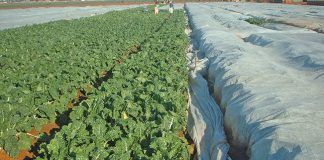
Photo: Christopher Scott/Gallo Images
Following the International Sorghum Conference held in Cape Town in 2018, the Department of Science and Innovation (DSI) embarked on a two-year study to determine the challenges and needs of the sorghum industry in South Africa.
Because sorghum is resilient to climate change and able to withstand drought, heat and waterlogging caused by erratic rainfall, it is considered a good alternative to maize, currently the most important food crop in sub-Saharan Africa.
According to the study, published in Market Opportunities for Sorghum in South Africa, the objective is now to boost the competitiveness of sorghum and increase local production to 500 000t per annum. The plan is to grow local consumption by 15% per annum and also to increase the export market by 250 000t per annum.
To achieve this, 100 000ha of new sorghum must be planted and a rural hub for sorghum food processing established in the Eastern Cape to exploit entrepreneurial opportunities.
Teaming up with the AIH Group, the DSI also involved farmers, seed suppliers, processors, and the Sorghum Forum, which comprises Grain SA, the National Agricultural Marketing Council, Southern African Grain Laboratories (SAGL) and the South African National Seed Organization.
Research and development support was sought from local and international agricultural and grain research institutions.
The study found various financial, processing, consumer and producer constraints to scaling up sorghum production in South Africa.
The fact that sorghum is the only grain on which VAT is payable has further negatively effected its competitive position in the market.
Over the years, the consumption of traditional African beer, which is made using sorghum, has declined due to changing consumer preferences, while the high price of sorghum has constrained its growth for use as meal and porridge.
DSI’s sorghum cluster master plan stands on five development pillars:
- An advanced germplasm development programme;
- Establishing a sorghum promotion agency or a Sorghum Checkoff;
- Removing VAT from sorghum and sorghum meal and excise duty on pasteurised traditional African beer, as well as a possible import duty;
- Promoting inclusivity and food security by means of a pilot sorghum project in the Eastern Cape;
- Securing yield gains through precision agriculture and extension services.
The DSI study recommends the replacement of imports, exploiting export opportunities and also growing the local market. Import replacement can accommodate up to 60 000t of additional demand for local sorghum, while access to markets in sub-Saharan Africa, where there is a shortfall in supply, can be filled by 220 000t per annum, which is currently being supplied by the US and Argentina.
Local sorghum demand can increase by 40 000t per annum in a market for competitively priced traditional African beer-type products, such as instant beer powder and pasteurised traditional African beer.
The DSI also foresees increased human consumption of up to 18 000t per annum in the form of bakery flours, meals, instant porridge, flours and liquid-soured non-alcoholic beverage-type products.
Two types
Currently 64 sorghum processors are involved in the production of mainly meal, rice and
grits, but also for indoor and floor malting, as well as pet food, poultry and livestock feed, according to the South African Grain Information Service (SAGIS).
There are two types of sorghum grown locally: sweet and bitter sorghum. The Supply & Demand Estimates Committee (S&DEC) projects the total use in the 2021/22 marketing year will amount to 10 600t sweet and 56 305t bitter sorghum. Sweet sorghum is processed mainly for meal, rice and grits, while indoor malting utilises bitter sorghum.
South Africa is a net importer of sorghum, with more than 50% of its consumption originating mainly from Botswana, and a small portion from Ukraine. Interestingly, Botswana was once an export market for South African sorghum, but has now largely become self-sufficient.
Increased imports of sorghum at competitive prices from the US resulted in local farmers selling at import parity prices, further exacerbating the margin squeeze at processors. Processors are thus reluctant to develop sorghum-based products due to compressed profit margins, and therefore sell sorghum products for the same price as similar maize products.
However, sorghum production is more expensive than maize production due to lower yield in comparison with input costs. Farmers prefer higher-yielding crops that are more profitable. Due to low demand, seed companies have withdrawn seed development support for South African sorghum growers.
Internationally, sorghum plays a significant role in grain markets in the US and Australia, as well as some African countries. Trade in sorghum is mostly for animal feed, except in Africa, where it is used for food; up to 250 000t are exported from the US to sub-Saharan Africa per annum.
China remains the world’s leading sorghum importer, while the US is the world’s largest sorghum producer at 9,5 million tons, followed by Nigeria with 6,9 million tons. In South Africa, sorghum production reached a peak in 1966/67 with 728 000t produced on 640 000ha, but declined to only 115 000t on 28 800ha in 2017/18. Early predictions for the 2021/22 sorghum season are very promising, however, with production expected to reach 209 980t, and yields predicted to reach an all-time high of 4,27t/ha.
Research funding
Locally, the Sorghum Trust, which was established after the termination of the Sorghum Board in 1997, is a cash-strapped industry body. The trust is sharply focusing on how it spends its remaining funds in the absence of statutory levy collections since 2018.
Currently, the investment value of the trust amounts to R24,5 million, which should be sufficient to address the funding needs of the industry for at least the next 10 to 15 years.
At the 2021 annual general meeting of the Sorghum Forum recently, Sorghum Trust chairperson Willem Groothof reported that the trust continued to focus on research, market information and transformation, and that this past year, it distributed a total of about R1,76 million for this purpose.
Research focused on advancing the industry has been supported by an amount of R604 981. A portion of this went to SAGL for the Sorghum Annual Crop Quality Survey, which outlines general trends and seasonal quality differences, and also indicates quality difference between locally produced and imported sorghum.
In addition, SAGL evaluated 93 different sorghum cultivars and conducted a sorghum milling evaluation. This is important for the millers of sorghum, along with diastatic measurements for malting purposes. Funding was also allocated to Grain SA for cultivar evaluation trials to ensure the industry is internationally competitive and for research on measures to control flocks of red-billed queleas.
Potential agronomic problems are addressed in a project by the Agricultural Research Council and the University of the Free State, where sorghum cultivars are evaluated for their susceptibility to leaf blight and grain mould.
The Sorghum Forum, consisting of sorghum producers and participants in the agro-processing value chain, continues to focus on the challenges of maintaining a globally competitive sorghum industry amid a changing market environment and limited funds.
What it costs
Meanwhile, the implementation plan of DSI and the Technology Innovation Agency, the two leads in the initiative, projects the costs of establishing a sorghum cluster will amount to R3,8 million. Germplasm development will need an investment of R25 million over five years.
A further R43,6 million will be required to establish the Eastern Cape rural processing facility.
Email Mariana Purnell at [email protected]. Read the cultivar evaluation report at sagl.co.za.











